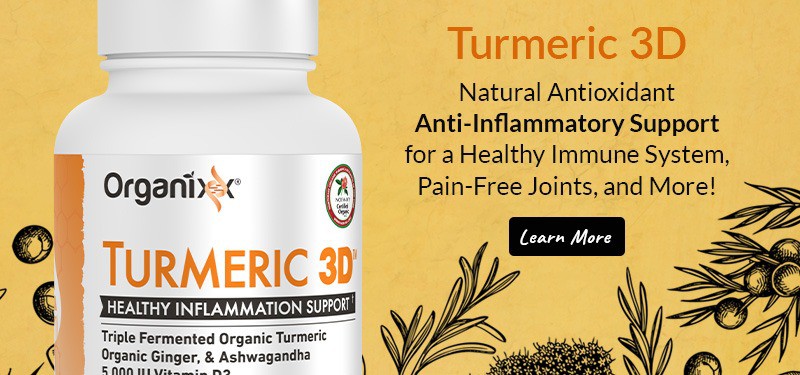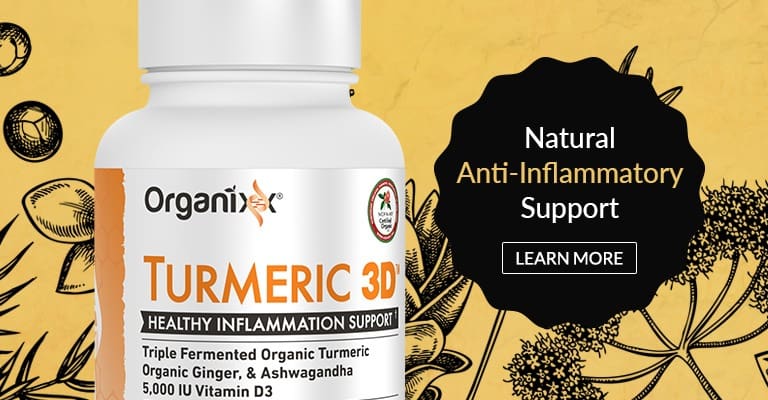Growing older. It’s one of the few things that all human beings have in common – regardless of race, gender, socioeconomic status, or education level. There’s not a person on the planet who (while living), can escape its inevitable, youth-robbing clutches… or is there?
While it’s impossible for any individual to stay young forever, growing old doesn’t have to look the same for everyone. Some people seem to have been blessed with the joy of a more “graceful” transition into old age, while others tend to wear the physical evidence of a life long-lived far more prominently.
So, what’s to account for this apparent dichotomy in what it means to grow old? Is it all just a matter of random chance? Or are there identifiable factors at play that impact whether an aging person ends up looking eternally youthful for their age, or more like a character from The Walking Dead?
Inflammation Gone Awry: The Sworn Enemy of Healthy Aging
At a fundamental level, the human body is made up of trillions of tiny cells that are genetically programmed to keep a person as healthy and functional as possible. They’re able to do this by undergoing routine maintenance, meaning some cells reproduce to replace old, defunct ones, while others undergo varying degrees and cycles of restoration and overhaul on an as-needed basis.
The human body also has an innate immune system that oversees the maintenance of this system of cellular health. One of your immune system’s core responsibilities is to send out repair crews to take care of any problems that might arise.
This critical immune response is better known as inflammation – and without it, you wouldn’t live very long.
Whenever you injure yourself or contract an infection, for instance, inflammation rises to the occasion and takes care of it as quickly and efficiently as possible. Its effects might manifest as swelling or redness at the site of a wound, or perhaps a fever if the damage is internal and systemic.

Acute Inflammation: The “Good” Kind of Inflammation
This short-term, or acute, response by the immune system to an invading threat is completely normal and necessary to maintain life.
It’s a natural biological response by the body to any harmful stimuli that it encounters. It often involves repairing or removing old and damaged cells, clearing out disease-causing pathogens, or simply restoring balance to the immune system itself [1].
In other words, the purpose of inflammation is to heal the body, not to harm it.
This type of acute, or transient, inflammation is often called “good” inflammation because it’s merely a temporary response to an invading threat. Because it only sticks around for a short time, healthy tissue is protected, and the body remains in an optimally functional state.
But what happens when inflammation goes rogue and doesn’t stop inflaming?
The “Bad” Kind of Inflammation (aka Chronic Inflammation)
This persistent type of inflammation is generally referred to as chronic inflammation, and it encompasses any type of inflammation that lingers around indefinitely.
Chronic inflammation is a dire situation regarding human health and longevity that quite literally adds insult to injury – turning what the body originally intended as constructive and health-promoting into something that’s profoundly destructive.
Chronic inflammation not only makes an already bad situation worse, but it can also cause even more health problems for the body – including by rapidly aging it!
How “Inflammaging” Causes Premature Aging
Dr. Claudio Franceschi, MD, from the University of Bologna in Italy, is credited with coining a term to describe this type of out-of-control, chronic inflammation that leads to premature aging: inflammaging.
In a paper published in the Annals of the New York Academy of Sciences journal back in 2000, Dr. Franceschi explained how inflammaging results from a systemic breakdown in the body’s ability to adequately cope with, and respond to, some type of pro-inflammatory onslaught [2].
In many cases, it’s a situation in which the immune system bombards a given threat with leukocytes, plasma proteins, antibodies, and various other inflammatory “soldiers,” only to have that threat persist. Sometimes this chronic inflammatory blitz continues even after a particular threat or trigger has subsided, representing another facet of inflammatory malfunction.
Symptoms Are Often Not Noticeable At First
Regardless of the scenario, runaway inflammation in all of its forms is harmful just the same. It will always result in the same prolific damage to the body that is a primary cause of inflammaging in our world today. Perhaps the worst part about it is that it often goes unnoticed until serious health problems suddenly arise.
The reason for this is that inflammaging, like other forms of chronic inflammation, is typically low-impact when it first starts… wreaking havoc slowly and quietly over an extended period. By the time noticeable symptoms start to appear, in other words, it’s often already too late.
In a best-case scenario, the damaging effects of inflammaging will manifest in somewhat “minor” ways like random mood swings and cognitive decline. The reason these conditions can be described as minor is that, in a worst-case scenario, inflammaging can rear its ugly head in the form of life-threatening illnesses like cardiovascular disease and cancer.
Inflammation Is Connected to Almost All Major Disease
Believe it or not, the type of chronic inflammation that’s characteristic of inflammaging is widely believed by many in the scientific community to be the cause of pretty much all major diseases – the direct consequence of persistent, low-level inflammatory activity that never fully “shuts off” like it was designed to do.
So instead of repairing and rejuvenating cell tissue for the benefit of human health, inflammaging systematically destroys it. It’s part of the reason why the blanket term “inflammation” generally has a bad name in the modern medical lexicon – even though it’s chronic inflammation that’s technically the bad guy.
Molecular and epidemiological research alike is congruent in linking chronic inflammation to “a broad range of non-infectious diseases, perhaps even all of them [3].” One of these diseases, broadly categorized, is premature aging.
As explained in another study published in The Journals of Gerontology, inflammaging represents: “…a highly significant risk factor for both morbidity and mortality in … elderly people, as most if not all age-related diseases, share inflammatory pathogenesis [4].”
In other words, inflammaging is a certifiable death sentence if it isn’t properly addressed. Persistent, low-level inflammation that never stops inflaming can, and typically will, spiral into one or more of a host of very serious diseases later on in a person’s life. Not to mention its direct impact on aging in terms of how it makes a person suffering from it look and feel.
The Negative Impacts of Inflammaging on DNA and the Body’s Cellular “Blueprint”
Getting back to the trillions of cells in the body that we talked about earlier, every individual is equipped with a unique genetic blueprint that contains instructions about how to keep every bodily system in tip-top shape. This includes cellular “guidelines” about the proper upkeep of the immune system, which is where inflammation (both healthy and unhealthy) begins.
But like with everything in life, this blueprint can get frayed throughout a person’s life. As individual cells undergo their normal process of routine maintenance, disposal, or regeneration, depending on their unique type and purpose, they don’t always live up to their predecessors in terms of efficiency and effectiveness.
 This degenerative process, also known as entropic decline, is described in one study as the body’s “slow, inexorable slide into non-functionality caused by stochastic degradation of its parts.”
This degenerative process, also known as entropic decline, is described in one study as the body’s “slow, inexorable slide into non-functionality caused by stochastic degradation of its parts.”
This is basically just a fancy way of saying that, with each new cycle of repair or replacement that occurs within a person’s cellular matrix, that person’s body as a whole loses some of its functionality.
Again, how this manifests will vary from person to person. For some, it might look like a slow deterioration in physical ability, or the swapping out of firm, glowing skin with wrinkles and sagging skin. For others in more dire straits, it might look like the development of a debilitating autoimmune disease, or worse: a terminal illness leading to early death.
Inflammaging Speeds Up the Aging Process
While this progressive breakdown is a natural part of the human condition, it’s important to note that inflammaging only accelerates this damaging process. It actively chips away at the structural and functional integrity of cells and other molecular components that the body relies on to prolong youthfulness for as long as it possibly can.
Researchers from the United Kingdom who took a closer look at this biological phenomenon found that not only does inflammaging have a profoundly damaging effect on otherwise healthy cells, but it also fights against the very systems that are intended to protect them, including vital DNA strands that are programmed to keep the body biologically young [5].
How Aging Actually Impairs Healthy Inflammation
What we can conclude from all of this thus far is that one of the major hallmarks of aging is an increase in “bad” inflammation. But why is this the case? On the one hand, growing old naturally leads to more health problems, which necessitate the immune system reacting with an inflammatory response for corrective measure.
But the other side of the coin is that the aging process itself actually inhibits the body’s natural ability to use inflammation for good rather than bad. With age comes a natural decline in immune function, which means it’s less able to utilize the inflammatory mechanism as a way to heal rather than cause more harm.
An immune system that’s beleaguered due to being old and worn out simply has a harder time fighting off invading threats than a healthy, younger immune system.
healthy, younger immune system.
This, combined with ever-decreasing cellular function as a result of old age, is a surefire recipe for out-of-control inflammation, which basically goes haywire trying to bring everything back into balance.
When cells become rickety and diseased as result, their mitochondrial “engines” rapidly lose their ability to properly utilize oxygen for energy production purposes.
This can lead to systemic mitochondrial dysfunction, which we now know is yet another cause of impaired inflammatory function [6].
The Destructive Inflammation/Aging Cycle
In many ways, it’s an exponentially compounding situation of immune and inflammatory breakdown that leads to even more bad inflammation, which contributes to more aging, which in turn causes more bad inflammation, and so on. And unless something is done to throw a wrench into this destructive spiral, it will only continue to worsen at an ever-accelerating rate.
4 Telltale Signs That Inflammaging May Be Taking a Toll On Your Body
Given its often undetectable nature early on, inflammaging tends to be a ticking time bomb, of sorts, with no audible tick until it finally explodes – often unexpectedly.
Even so, there are some early warnings signs that could suggest it might be lingering in the wings, just waiting for an opportunity to make its move.
Here are four signs your body may be giving you:
- Chronic pain with no apparent cause is one prominent indicator that something isn’t quite right in the inflammation department. If you’re one of the more than 100 million Americans who suffer from persistent body aches that have no apparent cause – and that never really seem to go away – inflammaging could be the culprit.
- Frequent illness, even of the minor variety, might be another potential indicator. If you’re the guy or gal who has always got the sniffles or who always succumbs to the debilitating sway of flu season, chances are your immune system is struggling due to an underlying inflammatory overload.
- If you’re easily agitated or have a hard time keeping your cool, or suffer from persistent brain “fog,” these could be additional signs of a chronic inflammatory threat – especially if such temperament symptoms would seem to have popped up out of nowhere.
- Though a slightly tougher one to pinpoint, yet another potential sign of inflammaging is a noticeable disparity between your chronological age and your internal biological age (in other words, you look older than you are). If the number assigned to you based on your birth year seems to be far lower than the number you would associate with how you think you should look and feel for your age, your body could be under attack by chronic inflammation.
The good news is there are countless ways to prevent inflammaging from gaining a foothold, and even helping to reverse some of the damaging effects, through lifestyle and supporting the body with supplementation.
We have many articles in our INSPIRED Living Library that address issues of inflammation, immune support, and an overall healthy lifestyle to help you counter the effects of inflammaging.
Turmeric 3D from Organixx provides you one of the most “bioavailable” forms of turmeric due to its unique fermentation process. This means your body experiences the maximum benefits of the purest, most potent turmeric available!

If you keep up with health news, you’re probably familiar with the buzzword inflammation and the ongoing discussion about the potentially harmful direct and side effects it can have on our health.
In fact, some health experts such as Dr. William Joel Meggs – an inflammation specialist at the Brody School of Medicine at East Carolina University and the author of the book The Inflammation Cure – even make the bold claim that inflammation ”may well turn out to be the elusive holy grail of medicine, the single phenomenon that holds the key to sickness and health.”
What Is Inflammation?
Before we try to understand why inflammation is so important and how it affects our health, let’s first consider the simple but very important question: what exactly is inflammation?
Simply put, inflammation is an important and necessary part of the healing process (i.e., our natural immune response). Its job is to protect our body against harm by:
- defending it against foreign invaders
- fighting off infections and illnesses
- repairing damaged cells and tissues in our body after injury
Normally, our immune system triggers inflammation when it recognizes anything that is alien in our body.
Such triggers can include invading bacteria or viruses, cigarette smoke, plant pollen, and the many thousands of synthetic chemicals we are exposed to during our lifetimes.
Inflammation Is the Body’s Response to Injury
We’ve all experienced inflammation when we develop a fever, bruise our knee, or cut our finger. For instance, our body reacts in a very predictable way when we twist an ankle:
- Blood flow to the affected area increases, which is why it typically turns red.
- Fluids and proteins from blood enter the injured tissues, which can cause localized swelling.
- Finally, our immune system sends a small army of white blood cells to the rescue. These typically include neutrophils, which are usually the first to travel to the site of an infection or injury. Neutrophils can literally swallow damaged cells and foreign invaders and also release enzymes that kill them.
Neutrophils may be accompanied by macrophages, another type of white blood cell that engulfs and “eats” anything not seen as healthy or normal.
In other words, short term or “acute” inflammation is a necessary, health-preserving component of our immune system’s response to injuries and infections. Without it, injuries could linger on and harm us, while even minor infections could turn deadly.
However, the key to the inflammatory process is that it is only meant to last a short time. Once our body has dealt with and gotten rid of the initial trigger or cause, the process of healing and repair should ideally begin.
What Is Chronic Inflammation?
Unfortunately, when our body’s inflammatory response goes on for too long or spirals out of control – known as chronic inflammation – it can lead to many adverse health conditions, according to health experts.
Chronic inflammation can happen when our immune system sometimes sends an inflammatory response to a perceived threat that doesn’t really exist.
At other times, the threat may be real but goes on for so long that our body’s inflammatory response also persists for a long time.
Persistent, uncontrolled inflammation – which has been linked to external factors we’ll discuss below – is damaging because it acts like a slow-burning fire, continuing to send out immune cells that eventually begin to attack healthy cells and tissues in our body.
According to Dr. Andrew Luster, of the Center for Immunology and Inflammatory Diseases at Harvard-affiliated Massachusetts General Hospital,
“It’s a smoldering process that injures your tissues, joints, and blood vessels, and you often do not notice it until significant damage is done.”
The Role of Free Radicals
Harmful free radicals, including reactive oxygen species (ROS), are believed to be the underlying cause of the damage to healthy cells caused by chronic inflammation.
Not only that, scientific research suggests that certain free radicals can directly initiate or even amplify inflammation by turning on several different genes that are involved in triggering and maintaining the inflammatory response.
These free radicals, including ROS, are likely created by the actions of the various immune cells that have been activated by the inflammatory process, specifically by the chemicals and enzymes they release into our body’s damaged tissues.
What is Chronic Inflammation Responsible for?
Chronic inflammation is now known to cause the buildup of plaque in arteries known as atherosclerosis. Our body sees such plaques as abnormal, so it tries to wall them off from flowing blood. But when that wall breaks down – and it eventually does – the plaque can rupture.
The plaque’s contents then mingle with blood, forming a clot that can block blood flow downstream where the blood vessel becomes narrower. These clots are responsible for most of the deadly heart-related health conditions (e.g., heart attack) that affect many people today.
Similarly, the more visceral fat cells we have – this is the kind of fat that builds up in the abdomen and wraps itself around organs – the more likely it is that our immune system sees them as a threat and triggers inflammation. As a result, more white blood cells enter our blood looking for a fight.
In other words, the longer we stay overweight or obese, the longer our body remains in a state of constant inflammation. According to Dr. Luster:
“This reaction is not confined to one particular place either. Inflammation can travel throughout the body and cause problems all over.”
Chronic inflammation is now believed to also contribute to the development of clinical depression and anxiety, generalized body pain, gut health disorders, and abnormal levels of tiredness or fatigue.
So, the question is: what triggers chronic inflammation and how can we manage these risks to reduce or even completely avoid our chances of developing an inflammatory condition?
What Causes Inflammation? Top 10 Offenders
Here are the top ten worst offenders believed to cause or contribute to chronic inflammation:

#1. Foods with a high glycemic index (GI) and added sugar
These include processed and refined foods such as white flour, instant mashed potatoes, and polished white rice, sweetened foods such as cakes, cookies, and muffins, and many commercially available breakfast cereals, breads, and pasta sauces.
The glycemic index (GI) is a ranking of carbohydrates on a scale from 0 to 100 according to the extent to which they raise our blood sugar levels after consumption. High GI foods are rapidly digested, absorbed, and metabolized by our body and cause significant fluctuations in our blood sugar levels.
Low GI carbs produce smaller fluctuations in our blood glucose and insulin levels; and according to many health experts, they represent one of the secrets to long-term health.
A 2002 study showed that processed sugars and high GI foods increase inflammation levels, leading to a greater risk of developing other health disorders. On the other hand, consumption of whole grains has been shown to reduce levels of the inflammation markers C-reactive protein and plasminogen activator inhibitor type 1.
High GI foods and excess dietary sugar likely trigger inflammation because they increase levels of chemical compounds in our body known as advanced glycation end products (AGEs), along with raising our risk of developing insulin resistance and harmful changes in lipid metabolism.
Scientific evidence shows that AGEs trigger inflammation in multiple ways. AGEs have also been shown to interfere with our body’s natural antioxidant defense systems and may even contribute to organ damage, compromising our health.
#2: Trans fats
A small amount of trans fats occurs naturally in certain animal foods. However, most of them are synthetically made in an industrial process that uses high pressure and chemicals to add hydrogen to liquid vegetable oils to make them more solid and have a longer shelf life.
The resulting end products, known as “partially hydrogenated oils,” are difficult for our body to process and end up triggering inflammation, at least partly by damaging cells in the lining of our blood vessels.
In 2013, the U.S. Food and Drug Administration (FDA) determined that partially hydrogenated oils are no longer Generally Recognized as Safe (GRAS) in human food. Indeed, consumption of trans fats in 823 generally healthy women in the Nurses’ Health Study I and II was seen to raise their levels of markers of systemic inflammation.
In other words, consumption of foods and food-related products containing trans fats should be completely avoided, as they have been shown to harm our health.
#3: Saturated animal fats
Consumption of saturated animal fats has been linked to a greater risk of developing inflammation-related health disorders in a number of studies. For instance, one study showed that the composition of our beneficial gut bacteria changes after eating saturated fats, particularly those from dairy found in many baked and processed foods.
The study authors stated that “as the balance of [microbiome] species shift, it can trigger an immune response that results in inflammation and tissue damage.”
It should be noted that many health experts who are in favor of high-fat diets point out that studies on saturated animal fats don’t take into account the quality of animal fats being consumed.
They believe that fats from pastured, grass-fed animals do not cause damage to the body as do saturated fats from conventionally-raised (factory-farmed) animals that are fed grains.
How meat is cooked is also a factor. Grilling protein foods such as meat and fish creates two kinds of pro-inflammatory chemical compounds – heterocyclic amines (HCAs) and polycyclic aromatic hydrocarbons (PAHs), which are also found in cigarette smoke. The charred bits at the edges of barbecued meat and fish are especially high in these toxic compounds. Cooking meats more slowly at lower temperatures is the best way to avoid inflammatory HCAs and PAHs.
Overall, the take-home message with regard to saturated animal fats is to consume quality sources and be careful not to overheat them.

#4: Excessive alcohol consumption
Our liver breaks down most of the alcohol we consume before our kidneys get rid of it. Unfortunately, the very process of breaking alcohol down generates toxins even more harmful than alcohol itself.
These so-called “byproducts” of alcohol metabolism damage our liver and kidney cells, promote inflammation in our body, and weaken our natural defenses.
While our liver and kidneys are especially vulnerable to alcohol-induced damage, other organs can also be damaged, and many of our body’s metabolic functions can be disrupted by excessive alcohol consumption.
Heavy drinking, even for a few days, can also cause fat to build up in the liver, a condition known as steatosis, or fatty liver, which is the earliest stage of alcoholic liver disease. The fat buildup makes it more difficult for the liver to do its job properly and can lead to dangerous, life-threatening conditions such as alcoholic hepatitis.
Also, certain bacteria in our gut make a compound known as lipopolysaccharide (LPS), which has been shown to induce inflammation. Unfortunately, alcohol consumption greatly increases the transfer of LPS from our gut into our bloodstream. When we are healthy, the adverse effects of LPS are kept under control. For example, the liver plays a central role in detoxifying LPS.
However, regular and especially excessive alcohol intake damages both our gut and liver over time, leading to persistent systemic inflammation caused by LPS, and ultimately, to irreversible organ damage.
#5: Celiac disease
An estimated 3 million Americans suffer from celiac disease, a common heritable chronic inflammatory condition of the small intestine—and up to 30% of U.S. adults now want to avoid or cut down on gluten in their diets, according to a recent survey.
Gluten is a spongy complex of proteins found in wheat, barley, and rye that allows dough to rise. As foods containing these grains are baked, yeast ferments sugar and releases carbon dioxide, causing gluten to inflate, giving breads and cakes their familiar texture.
Celiac disease occurs when small gliadin proteins (a component of gluten) that are resistant to complete digestion directly affect intestinal cell structure and function by manipulating gene expression and via oxidative stress. This provokes a powerful, misdirected inflammatory response from our immune system and white blood cells.
As we continue to eat foods containing these proteins, the state of inflammation in our body becomes chronic. This continuous “friendly fire” ends up damaging microscopic finger-like structures known as villi that line our small intestine, which are specialized for nutrient absorption. Ongoing damage to villi leads to typical symptoms of celiac disease such as belly pain, diarrhea, iron deficiency, and other digestive issues.
#6: Smoking
Cigarette smoke has long been known to be very harmful to health. Several toxins in the smoke interact with our immune system with adverse consequences. These toxins induce chronic inflammation at the membranes lining our oral, gut, and lung cavities, which is helped along by harmful free radicals known as reactive oxygen species (ROS).
Chronic obstructive pulmonary health disorders (COPD) – also known as chronic bronchitis or emphysema – are a leading cause of death all over the world.
A progressive health condition that makes it hard to breathe and gets worse over time, COPD causes prolonged coughing with large amounts of mucus, wheezing, shortness of breath, chest tightness, and other symptoms.
Cigarette smoke is the leading cause of COPD. Up to 75% of people who have COPD smoke or used to smoke. However, long-term exposure to other lung irritants, such as pipe, cigar, and other forms of tobacco smoke, air pollution, chemical fumes, or dust can also contribute to COPD.
Furthermore, cigarette smoke is known to modify our immune system’s responses to external antigens, along with adversely affecting our innate immune defenses and promoting autoimmune disorders. [Note: antigens are molecules capable of generating a response from our immune system.]
#7: Chronic, uncontrolled stress
Major life stressors, including those involving interpersonal stress and social rejection, are now thought to trigger inflammation by increasing levels of pro-inflammatory cytokines in our bloodstream. [Note: cytokines are small secreted proteins released by various immune cells, which have specific effects on the interactions and communications between immune cells].
These cytokines are now also known to cause profound changes in our behavior, including mood suppression, an inability to feel pleasure, as well as fatigue, and social withdrawal.
This behavioral response to adverse social circumstances may have originally had some survival value. However, in the present day, it may be over-activated by social, symbolic, and imaginary threats.
This connection between long-term social stress and inflammation may explain how and why mood health disorders develop, why they are strongly predicted by early life stress, and why they might coincide with certain physical health disorders also known to be triggered by chronic inflammation.

#8: Overweight and obesity
Obesity is a global epidemic whose prevalence is increasing, with more and more younger people being affected in both developed and developing countries.
Scientific and clinical evidence shows that obesity triggers inflammation – a low-grade, chronic level of inflammation that takes place in cells in fat tissue, liver, muscle, pancreas, and brain in response to too much nutrients and energy.
This “metabolic” inflammatory response is known to contribute to insulin resistance and various metabolic health disorders. For a long time, fat cells (known scientifically as adipocytes or lipocytes) were considered to be little more than storage cells. However, they are now known to be a critical component of how our body’s metabolism is managed.
Intriguingly, fat cells also secrete hormones directly into our bloodstream. In lean individuals, these hormones modulate body fat. However, as a person becomes overweight or obese, their enlarged fat cells begin to misbehave, immune cells known as macrophages start accumulating in fatty tissue, and long-term inflammation is the inevitable outcome.
These larger-than-normal fat cells also release many chemical molecules that increase our risk for various metabolic health disorders.
#9: High ratio of omega-6 to omega-3 polyunsaturated fatty acids
Both omega-3 and omega-6 polyunsaturated fatty acids (PUFAs) are “essential” fatty acids that are absolutely necessary for maintaining our health and well-being. However, our bodies cannot make them on their own, so we have to get them in our diet. Both PUFAs play a crucial role in our brain function, and in our normal growth and development. Historical evidence indicates that human beings have evolved on a diet with a ratio of omega-6 to omega-3 PUFAs of approximately 1:1, or at best 2 or 3:1.
Whereas in the standard American diet (SAD) of today, this ratio is as high as 15 or even 20 to 1. In other words, most present-day western diets are seriously deficient in omega-3 PUFAs and contain excessive amounts of omega-6 PUFAs.
A proper balance of omega-3 and omega-6 PUFAs is believed to be health-promoting because omega-3 PUFAs help to reduce inflammation. On the other hand, consumption of excess omega-6 PUFAs – such as those found in corn, safflower, sunflower, grapeseed, soy, peanut, and vegetable oils, mayonnaise, and many salad dressings – can trigger an inflammatory response.
Therefore, a high ratio of omega-6 to omega-3 PUFAs in our diet is believed to contribute to the development of inflammation-associated health disorders.
In support of this theory, a ratio of 4:1 of omega-6 to omega-3 PUFAs was seen to be associated with a 70% decrease in the death of patients with heart-related health problems (heart disease).
Similarly, a ratio of 2 to 3:1 was seen to suppress inflammation in patients with joint-related problems, whereas a ratio of 5:1 had a beneficial effect on patients with asthma.
In other words, a low ratio of omega-6 to omega-3 PUFAs – similar to that seen during early human evolution – may be ideal for reducing our risk for the many chronic illnesses that are prevalent globally today.

#10: Pollution and environmental toxins
Today we live in a “toxic soup,” with pollutants all around us that adversely affect our health and well-being.
According to experts, more than 80,000 hazardous chemicals contaminate the air we breathe, water we drink, food we consume, skin and hair care products we use regularly, and household cleaning products we try to protect ourselves with.
For instance, the air around us contains many toxic pollutants. These enter our bodies through our eyes, skin, and lungs and cause serious health problems, including at the immunological, neurological, reproductive, and developmental levels.
Health experts believe there’s a connection between the massive levels of airborne pollutants and the dramatic increase in the prevalence of asthma and allergies worldwide over the last few decades.
Airborne toxins are now known to adversely affect the development, balance, and activity of our immune system, and therefore, our ability to generate an inflammatory response with far-reaching consequences for our health throughout our lives.
Toxins in our water supply can be readily taken up by the body through our skin. For example, while bathing or showering. Chlorine and fluoride can be present in tap water, lead can leach into home water supply from pipes, while well water can be contaminated by toxins in groundwater.
Further, many of our health problems today are believed to be related to the changes in the way farming is carried out, including genetically-modified (GMO) crops sprayed with massive amounts of herbicides containing gyphosate.
Not only that, mass food production methods – wherein growth hormones and antibiotics are routinely used in cattle and poultry farming, food irradiation is used to make food safer, herbicide and pesticide use is standard practice, and food is enhanced with food additives such as preservatives – are pumping more toxins into our body and playing havoc with our health.
Constant exposure to all these environmental toxins promotes a state of chronic inflammation and oxidative stress (defined as a disruption in the balance between ROS production and our antioxidant defenses) in our body, along with interfering with glucose and cholesterol metabolism, inducing insulin resistance and metabolic disorders, disrupting mitochondrial function, and altering thyroid metabolism.
Summary
In summary, inflammation is an important and necessary part of our natural immune response, which is designed to protect us against various types of harmful situations. Short-term or acute inflammation is necessary for good health, but it is only meant to last a short time.
When our body’s inflammatory response is chronic and goes on for too long, it can contribute to the development of many health disorders.
Damage to healthy cells and tissues in our body caused by chronic inflammation is believed to be mediated by free radicals, including ROS – and they can even directly initiate or even amplify inflammation.
So, what causes inflammation?
As seen in the detailed discussion above, the top ten worst offenders for chronic inflammation include overly processed, refined, and sweetened high GI foods, consumption of trans fats, poor quality saturated animal fats, excessive alcohol, celiac disease, smoking, being exposed to chronic, uncontrolled stress, being overweight or obese, consuming a high ratio of omega-6 to omega-3 PUFAs in our diet, and exposure to high levels of pollution and environmental toxins.
Turmeric 3D from Organixx provides you one of the most “bioavailable” forms of turmeric due to its unique fermentation process. This means your body experiences the maximum benefits of the purest, most potent turmeric available!



